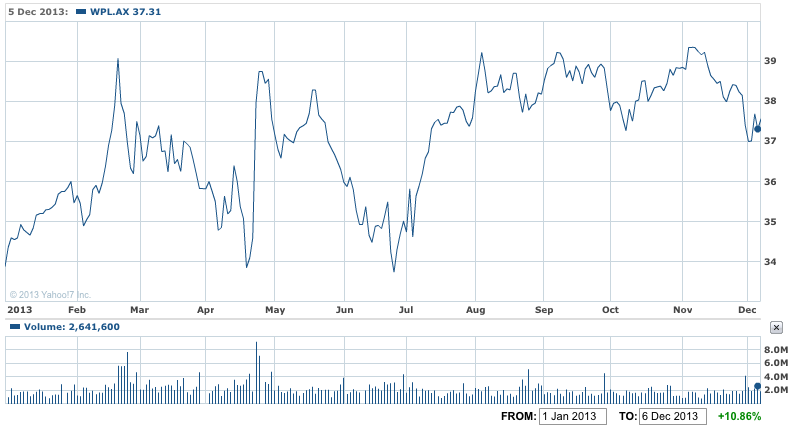Good news for 2013 and good news for 2014 from Woodside Petroleum (WPL) yesterday at an investor day update.
It told the market it would be spending less in 2014, but it would be producing more.
The news saw the company’s shares end 0.45% higher at $37.57.
Woodside told the investor day meeting that it was looking for a small rise in output next year.
WPL said it was now expecting to produce as much as 93 million barrels of oil equivalent as it benefits from recent project developments.
The 2014 production (range is 86 to 93 mboe) is expected to be split 39% from Pluto LNG, 23% from North West Shelf LNG, 14% from NWS Domestic gas and 24% from condensate, oil and LPG, according to Woodside’s briefing.
That was less than some market forecasts, but Woodside pointed out there are some maintenance periods next year, and it has lost a 1.5 mboe domestic gas supply contract that kicks in from 2014.
That compares to the 2013 forecast (which ends on December 31) of, between 86-88 million barrels of oil equivalent. Earlier this year it had forecast 2013 output in the range of 85-89 million barrels of oil equivalent.
Woodside said the increase would come from a full year of the Vincent oil field and more production time from the Pluto project (which has been impacted by stoppages this year).
And on costs, the reduction isn’t due to the company getting all cost-conscious as other resource groups are (and as some international news reports claimed yesterday).
The spend is down because of delays in its plans to invest in the Leviathan export gas project in Israel. 2013 investment outlays are now estimated at $US1.1 billion ($1.2 billion) from $US2.3 billion expected forecast.
But the company still expects to be spending in 2014 with investment expected to range between $US2-2.4 billion.
That could change if there are further delays in Israel.
WPL YTD – Woodside confident about 2014 – it all depends on Israel gas investment

And the most interesting comment in the briefing notes was on LNG pricing where some analysts reckon the forecast surge of US production might force prices in the lucrative Asian market lower in coming years.
Japanese business media reports in recent weeks have said the spot LNG price has risen 30% since May to nine month highs of around $US18 per million btus [British thermal units] because of a supply tightness and the increased demand as Japanese economic activity expands. As well there are no signs of an immediate restart to any of the 50 plus nuclear reactors and power stations closed.
Woodside noted yesterday that:
"Long-term contract prices in Woodside’s target markets of North Asia continue to reflect historically high oil prices, while increased spot prices for the northern hemisphere winter indicate a tightening market that should prevail for the next several years at least.
"With a significant number of price reviews underway, price formulae adjustments under regional contracts are moving increasingly towards long- term landed average Japanese prices and benchmarks."
The importance of that comment is that long term Japanese price benchmarks are the highest in Asia and have risen in the past couple of years as Japan has shut nuclear power stations and sort of expanded other forms of energy use, especially LNG.
And, Woodside also revealed that it is cutting its exposure to the US.
"Following a strategic review of areas of future growth and focus, Woodside is scaling back its presence in the Gulf of Mexico.
"The company has signed purchase and sale agreements to sell its 20% interest in the Anadarko-operated Power Play field with effect from 1 August 2013. Closing occurred in November 2013. Further sale transactions are pending. Detail will be provided in our fourth quarter update in January," the company explained.
And still in the US, we can expect an update from BHP Billiton overnight Tuesday on its $US20 billion or so investment in America’s shale oil and gas sector.
The company yesterday released an updated outlook on the world, Asian and US markets for oil and gas, as well as the US shale gas market. The tone was upbeat – growth in demand was mentioned numerous times and a generally rosy outlook was painted.
So that would normally lead you to believe that there won’t be anything dramatic from the update on the US shale gas business, due out overnight Tuesday from the company on day two of the briefing in Houston, Texas. But don’t be too sure.
There have been enough hints from oil and gas analysts in recent months to indicate there is a lot of unhappiness among investors (especially big ones) at the performance of the shale oil and gas business assembled in the US by BHP. Already we have seen some write downs and something along those lines wouldn’t surprise.
Yesterday’s briefing from senior executives, led by CEO Andrew McKenzie repeated all the previous comments on cost-cutting and sales of unwanted assets, and there seemed to be a greater emphasis on how efficient BHP is becoming in managing its assets at low costs.
That’s why a recommitment to the US shale gas business, but under tougher cost controls and benchmarks, wouldn’t surprise from the overnight briefing.













